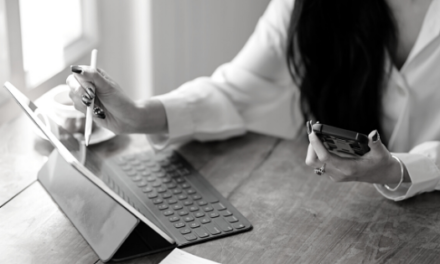With so many companies encouraging or even mandating that people work from home over global health concerns over the Covid-19 virus, people can expect their work styles to be severely impacted. The workforce of the future will likely see more people working flexibly. Having worked from home for four years now, I want to share some tips with you that will help you – I understand it can be overwhelming and hard to focus with so much going on. This is especially true if you are in an adjustment period from working in an office to working at home for the first time.

STEP ONE: Declutter.
If you’re working from a spare bedroom, a separate office, or even your own bedroom, it’s essential to make sure that your space is clutter-free and you can focus. Make your workspace as work-friendly as possible. This will also stop you from getting distracted. I do not recommend working from your bed as this needs to be kept separate for your sleep. Your brain will start associating your bed with work. Now that a lot of us are stuck at home, it’s vital to keep your rest spaces for exactly that… rest. It’s also much better for you in terms of being productive.
STEP TWO: Get in the right headspace.
To be in work mode, I need to feel like I’m in work mode, and I don’t feel like I’m in work mode when I’m in my pyjamas. Although you probably don’t want to put on a suit, having that routine of having a shower and getting ready for work really does help to mentally prepare for a day of work at home. You need to get yourself in a mindset that work time is for work and unrelated work things need to happen before and after the hours that you have put aside for work time.
STEP THREE: Make sure you have the right software.
You need to make sure you’ve got the right licenses and software that you need to attend meetings digitally. Make sure you check your company policies though – some companies have got stringent guidelines on what you can and can’t download onto your work computer. Personally, my favourite virtual platform is Zoom. It is fantastic, and it’s free to sign up. There have been some articles about the security issues though, so make sure you do your research. I’ve got the pro version, which is fabulous, but if you need a quick solution to attend a video meeting, it takes 30 seconds to sign up.
It’s great because you get your own personal meeting room and you can simply send a link to invite someone to it. With the pro-version, I can also hold group meetings,and I can record them to the cloud, Personally, I use a microphone because even though my computer and my phone have built-in camera and audio, the sound quality is significantly better with a microphone. The other good thing about Zoom is you can choose a virtual background. If you are in your bedroom or you’ve got kids running around in the background, you can impose this virtual background behind you and the person you’re talking to isn’t going to get distracted by what’s going on. (It also avoids embarrassing undressed partner situations!).
I also recommend that if you’re in a group meeting to mute yourself and press the space bar when you want to talk because dogs barking or kids laughing in the background is distracting. You don’t want the rest of the team listening to that. I also love Slack – it’s fantastic for sharing documents. Microsoft teams is also excellent – but what you need to do is investigate and find the one that’s right for you.
STEP FOUR: Up your internet.
Typically, home internet isn’t as good as what you would get in an office. When I first started working from home, it was one of the first things that I did. If someone else in the house is watching Netflix, you don’t want to be frustrated by your browser being super slow. Make sure you look at your package and pick something that is right for you.
STEP FIVE: You need to take regular breaks.
I use the time that I used to commute to now ease in to my day. I do exercise, I play with my kids, I do some reading, I might do an online course. It’s really important to stay off your phone during this time, particularly at the moment as it is so overwhelming and anxiety-inducing – all of the stuff that you need to be clearing your mind from. When you work from home, you do tend to plan your day around meal breaks, and a warning – you may find yourself eating more than you did when you were at the office. Scheduling proper meal breaks like you would if you’re in the office is a great tip here. For me, when I used to work full time in an office, having people stop at my desk for a chat or going into the kitchen to get a coffee as an extrovert, that was a massive energy boost. When you’re working at home as an extrovert, it can get pretty lonely. Taking breaks to call a friend to say hello is important. For introverts who are happy not to talk regularly, I still recommend that it’s essential to schedule in regular breaks. If you keep up the routine that was similar to what you did when you were going to the office, it will put you in the mindset of a day at work.
STEP SIX: Keep using your diary.
Writing a to-do list is okay, but I found that blocking out times in my diary and calendar made me so much more productive at work. It helped me to stay focused on what I needed to be doing in that time frame. I would block off times to work on specific projects and set reminders for important tasks.
STEP SEVEN: Eliminate distractions.
I found when I was working from home for some reason, I got so much more easily distracted. Simple tips like turning off the email notifications when you are head down in something makes a huge difference and please, stay off social media, especially at the moment. It is a vortex that can suck you in for hours.
STEP EIGHT: Avoid loneliness.
Make sure you check in with your friends and your colleagues regularly.Studies showed that after the SARS quarantine people showed signs of actual psychological distress and the highest reason was a sense of isolation. So those quick- “Hey, how are you going?” calls can go a long way, and you can also use this time to spend working on your networks. Are you connected to everybody you need to be on LinkedIn? LinkedIn is such a great platform at the moment, and you can use that time to make sure that you’re building those corporate networks. If you’re feeling lonely, if you’re feeling isolated, please do reach out to a friend during this crisis.
Be kind to yourself and others. Stay safe, keep calm and wash your hands.





















